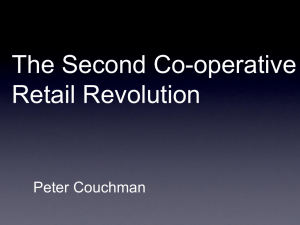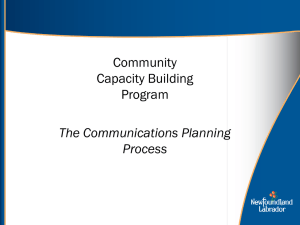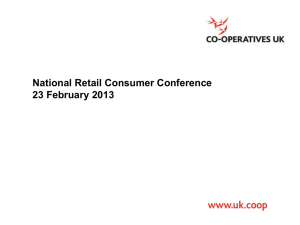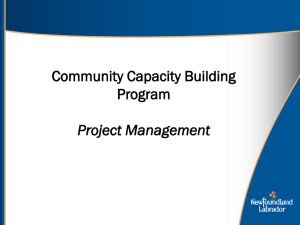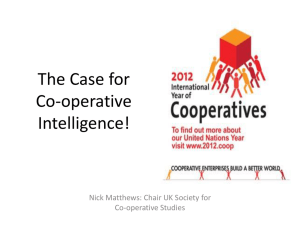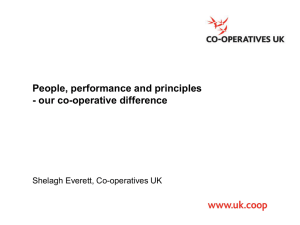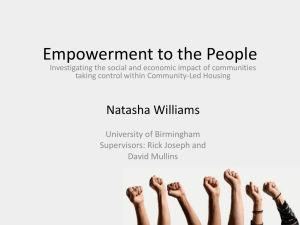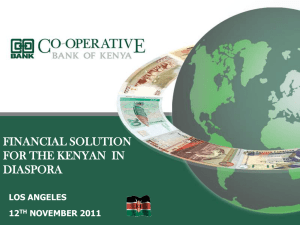Citizen Schools in Action: St Clere`s School, Specialist Science
advertisement
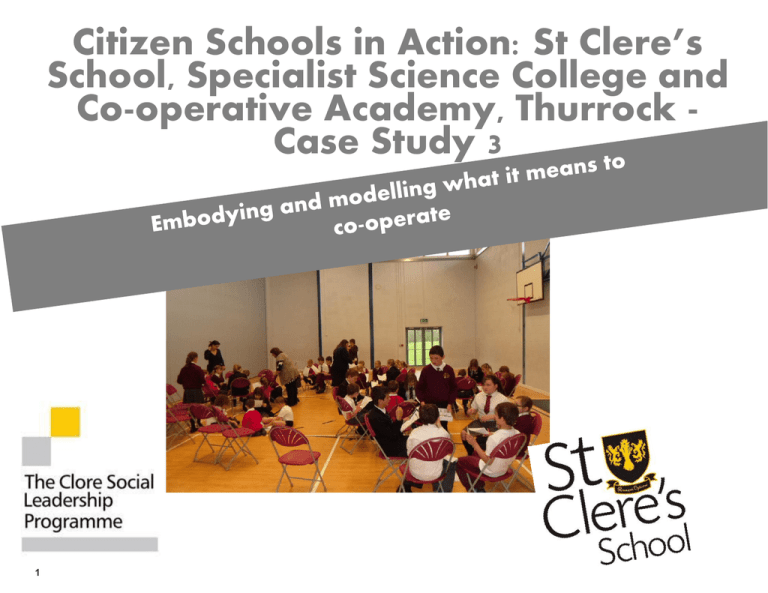
Citizen Schools in Action: St Clere’s School, Specialist Science College and Co-operative Academy, Thurrock Case Study 3 1 Now here’s the academic bit… Two researchers visited each case study school About twenty interviews were conducted with staff, students, parents, governors and community leaders looking at: 1. Individual development of citizens 2. Institutional development to support citizens 3. Interactions with the community Six researchers analysed all the data to identify common themes and met to discuss the findings Case study created with each school 2 We create civic governance: the Co-operative School story The 2006 Education Act allowed for a wide diversity of partners to participate in the running of maintained schools. Rather quietly, one of the more rapidly expanding partners, alongside foundation trusts and academy schools, was the co-operative model. Over 200 schools have now embraced Co-operative values. The Co-operative movement places democracy at the top within its organisation, and promotes an active membership of the wider community (over 13 million of us are members of a Co-operative). Facing the withdrawal of local authority accountability in education, Co-operative schools are providing new and imaginative answers to the demands of justice and accountability in school governance, and provide an alternative to both traditional bureaucratic democracy like local authorities and market based solutions. The Co-operative school story is the story of St Clere’s where alliances characterised by values of mutuality, reciprocity, and civic participation are being forged by the students and teachers every day. Out of that activity some exciting new ways of creating civic governance are emerging. 3 The two Co-operative bodies supporting schools St Clere’s School and Co-operative Academy: factoid Location: Stanford Le Hope, Thurrock Type of School: Co-operative Academy and Science College Number of Students: 1015 Student Profile: mixed gender, 11-16 comprehensive Results:64% 5 A*-C inc English & Maths, 90% 5 A*-C, 100% 1 A*-G Awards: Top 100 in terms of school improvement for each of the last four years (DfE). Top 10% of schools for student progress and top 10% of schools for continuous school improvement (SSAT) 4 The Team Headteacher: Paul Griffiths has responsibility for developing community partnerships between schools in the Trust and with external organisations. Deputy Headteacher: Ashlie Hughes is responsible for developing Co-operative learning and values through the curriculum. Assistant Headteacher: Joe Solis is responsible for developing Student Voice within St Clere’s, across the Trust and with other Co-operative Schools. Trust Secretary: Kate Draper is responsible for developing membership and for community liaison. Pupil Inclusion team: Jay Callendar, Deputy Head, responsible for inclusion, Claire Harrison, Inclusion Manager, Mary Brice, Attendance Officer, Julie Peak and Donna Dulligal, School Counsellors. Heads of Year: The five Heads of Year, Emily Catchpole, Laine Taylor, Keiran Parkes, Russell Davies and Colin Yeomans have overall responsibility for the pastoral care of students. All staff and pupils aspire to the Co-operative values of Self-help, Selfresponsibility, Democracy, Equality, Equity and Community. 5 How did it start? St Clere’s has been a high performing school with a good reputation within its local authority area for many years. The school originally became a Grant Maintained school in 1993, motivated by the ability to gain greater autonomy. The values of the school and its leadership team have always been about developing a high achieving school, and also a school that contributes to the wider education system for all young people in the local authority area of Thurrock. Seeing the direction of travel within the education system under the last government and the present coalition, St Clere’s moved to strategically ensure it maintained and could further its own individual success whilst sustaining the values of contributing and co-operating with the broader school system. The school therefore seized upon the opportunity to become at first a Co-operative Trust School in 2009 and then more recently in 2011 a Cooperative Academy. In April 2012 it formed a multi-academy Trust and was joined by East Tilbury Infant and East Tilbury Junior schools. These institutional changes, along with the focus on sustaining improvement to teaching and learning, now provide the focus for St Clere’s and other member schools within the Trust to sustain and develop their vision for education within the changing school system. The next phase of the Trust’s development is to institutionalise the structures, systems and culture outlined as they formed the Trust and develop a deeper and more meaningful teaching and learning practice connected to the values of co-operation. St Clere’s are also keen to explore how they can contribute to the scaling and replication of practice across the country. 6 St Clere’s has formed a Co-operative MultiAcademy Trust with East Tilbury Junior and Infant School and will sponsor Thameside Primary School in September 2012 7 Individual development: students learn they can each make a difference in the world by working together The move to become a Co-operative school built on a strong school ethos which encouraged students and staff to positively contribute to the local community. With these foundations the decision to investigate the co-operative model and proceed with it was described as a natural fit. Paul Griffiths, St Clere’s Headteacher for over 15 years saw the Co-operative model as a way that the existing values of the school could be further strengthened and expanded. He and colleagues speak about the desire they have for education to develop young people as members of society and how a Co-operative approach can support this: “I often say in assembly that we are here to provide you with an education that will get you the best results that you can achieve, and then I say that's half a story. Because of course schools are about qualifications for children, but if you only give children qualifications, you've done half a job, because in simple terms you're also developing the young person, and you're developing people who are going to take up their role in society. And if possible we need to make them feel as though they get involved, become part of it, make a difference, contribute. Being a co-operative school helps us to this.” Paul Griffiths, Headteacher. “So choosing to move forward with the cooperative model was one that we felt that we could really engage in. We'd already developed the trusting relationships with the other schools, so with that Co-operative model in mind, and the values of the equality, equity, compassion, respect, and responsibility, we knew that we were then in many respects protecting the identity of our school for the future.” Shelagh Cosgrow, Primary Headteacher 8 Individual development: a code for co-operation The institutional values of St Clere’s and the Co-operative model are now fusing together to further develop practice and culture across the school. John Purkiss, Head of PE sees the co-operative model develop citizenship through: “expectations of the school’s rules expectations of pupils, all those things embedded across lessons. It’s not just individual teachers, it’s a whole school policy informed by our co-operative approach to develop our young people as citizens.” 9 Individual development: a course in citizenship Looking at the curriculum of the school students learn the skills for Citizenship through a formally taught Citizenship CPD Course. “You learn how to be part of a community, and how to take part in meetings and decisions, so it's quite good. It think they're good lessons to be part of, and they kind of teach you a bit about society, what's out there and how to get involved.” Students Co-operative values and co-operatively informed pedagogy have also begun to spread across the school. An example is John Purkiss’ co-operative practice within PE lessons. “I was looking at how you could deliver co-operative working during lessons....stepping back and enabling the students to have great freedom and work as a team to problem solve and overcome mistakes…using cooperatively inspired teaching and learning has enabled students to work far more closely together, as opposed to individual work that might often be seen in a classroom.” “Students will be able to go in positively to the community and have those values. So I think that the school tries to teach students a sense of self resilience and to realise that once they go out into the job market they need those values of communication, cooperation. They need to build a perspective in students that enables them to think…I’ve already worked with the community, I can be a valuable asset. And what we do try and do is focus on skills within 10 lessons as opposed to like knowledge based approach to learning.” Phillipa Buckingham, Individual development: co-operative practice had spread into a wide range of lessons 11 Institutional development: equality enshrined in the school ‘rules’ The governance of Co-operative academy networks aims to ensure equality of power and shared equity in decisions and direction. All schools within the partnership have equal representation, and actively participate in the governance of the partnership. This enables parents, teachers and students to be represented, and to be actively involved too. Importantly it also gives the opportunity for members of the wider community to participate in school governance by becoming members of the cooperative, broadening the involvement and accountability of the school beyond its walls and those who have a direct self-interest as a student or parent. “Now the Trust board will be made up of members from all the schools in an equitable sense, which is very different from some of the other academies or academy chains. Any fundamental changes to the work that we're doing would require three quarters of all members to have to vote for any future change.” Kate Draper, Secretary to the Co-operative trust. Paul Griffiths describes how he hopes the decision making structures and the culture they enable will influence behaviour more widely. “My aspiration of course is that children will appreciate they live in a democracy and appreciate that by the use of their vote when they are able to vote, in the future it might be 16, but currently it's 18, they wont' take that granted, and so in our local elections we might get better turnouts, which you're probably aware are not very great in local elections. “ 12 Institutional development: inclusivity and equal power are key stones of St Clere’s Co-operative Multi-Academy Trust Academy Trust 13 Institutional development: Co-operation as preparation for the lives members want to lead At a time of significant change within the education system and wider society, the cooperative model implemented by St Clere’s has enabled four schools to come together and foster shared values, a sense of place, and yet also retain their individual identity. A range of perspectives enables a sense of the development taking place to be understood. “We’re able to work with staff across the Trust at different key stages who are going to help develop our current strengths. Everybody shares the vision as we move forward - it is about pupil voice, wider stakeholders in the community, and parents, and obviously our employees, the teaching staff, support staff, cleaning staff, everybody is included.” Primary Classroom Teacher “Yeah, I think people feel like, you know, I think they learn to be a better person, I think that makes you--, you feel like your part of--, you're a citizen, especially for St. Cleres’, like I think it's when you walk out the door to the minute you walk back in the door, you're part of St. Clere’s …So it kind of gets you in like the role for life that you are part of a society, like the school, and that you should respect that and respect each other.” St Clere’s Students “I think if they can see that every member of the community is valued in the co-operative, and every member has their own qualities and their own strengths, it will build--, the children will respect, have a lot more respect for people, and a lot more understanding I think. It's about seeing--, identifying that people are valued, and everyone is important.” Classroom teacher “What governors were really keen on was that the ethos of the school, which is very strong and includes all the community, should remain, and so it was that that the governors wished to protect. It was the values and ethos of moving forward. And then in terms of working with other institutions, as an infants school, we are the smaller of those institutions, retaining the credibility of the professionalism, expertise, within that particular area, and sharing that. That’s what the trust enables us to do.” Shelagh Cosgrow, Primary Head 14 teacher Interactions with the local community: a web of connections supports the students Membership of the co-operative is open to all those who live in Thurrock – students, staff, parents, community groups and organisations. This has seen St Clere’s reach out to work with schools beyond its co-operative, with other local co-operatives and with nationally run co-operatives too. Members of the co-operative offer their view on this work. “It really helps because we think--, we share--, we share a collective experience which makes us more confident we’re doing the right thing, especially when we can share experiences and problems. And the students know that they’ve got that sense of wholeness because they know, right, I come from here and I go there and I could go there and St Clere’s is still going to be supporting me and we’ve got strong links with the college they’re going to go on to. So they do feel very much like, they’re never isolated in any one place, so we’re all connected.” Philippa Buckingham, Classroom Teacher “And the national impact will be that we'll see a large body of schools operating with a certain clarity about Values and ethics.” Senior Teacher “And if you think about our international links with China and, you know, broadening out our International links then, parents, they’re sending their students abroad and things and having students stay with them from different countries and having their sons or daughters being taught Mandarin. Just a recognition that the world is changing, I think they definitely think, you know, St Clere’s is not involved in just the immediate community but it’s like broadens out into 15 international one.” Classroom Teacher the Interactions with the local community: the structure and values support community participation As changes take place to the role that local authorities play in education, the co Operative model is being seen by many as an alternative for the middle tier Organisation of schools. Here teaching staff offer their perspectives: “In some ways I do see the cooperative schools potentially being, not a replacement for local authorities, but another vehicle, another mechanism to work in partnership with what is left within our local organisation. Because you do have to drive cost down, and we can't waste money in bureaucracy. We have to be slim, mean, and able to move fast in this agenda. So I Think the Co-operative schools, which are not going to be blessed with the sort of, the sort of levels or, you know, structures that sometimes you see evolving in big organisations such as local authorities, we’ll be able to do things at a cost effective way. We’re also very clear view that we are not within this isolated community, we’re a part of a bigger community whereby our children will have relationships or families within the whole catchment area.” “It’s going against the sense of competitiveness, isn’t it. Whilst we’re a proud school and we do kind of like the fact that, you know, we might be a couple of percentage higher than the next school, at the same time we still want the area to succeed. We want the area to be made into an area that is full of achievement, you know, a prestigious area. I definitely think it could do with a lot of boosting in its self confidence. If you think about Essex, the negative stereotype that comes with that, we do need to sort of collectively get together and diminish those.” 16 Interactions with the local community: parents are enabled to contribute through the culture of Co-operation The co-operative values also support the building of local relationships and enable these relationships to become part of the practice, governance and Decision making of the school. “We invite the parents in every morning, we're very much open door. We try and bring in as many help-, as much help from outside as possible. If we know a parent's got a specific skill, such as she's worked at a special school before or anything like that, we bring them in. We try and encourage the community hall to be used for different events, not just school related but like karate and anything, so that the school becomes the hub for the community.” Primary Classroom, Teacher “So you've got your parent representative, staff, and community, your chair of governors. There is a representative on that board from the Co-operative movement to ensure the equity is in place. But each of the stakeholders has an equal voice in driving it forward. So the board is perhaps that strategic element. On a day-to-day basis in key stage 1, the initial part of the school day is that all parents and children come into school and share the tasks that are being done. So those 17 relationships, those close relationships are built up between teachers and pupils, So you have a Interactions with the local community: engagement and accountability “In PE we do a lot. We’ve got partnerships with for example a local cricket club, Horndon-on the-Hill. We’re now a site for them this summer for their cricket teams. So it’s opened up the school to the community. Also we worked with the local Community to develop an all weather pitch, and again that’s now a facility that’s open ten o’clock at night, every night of the week and it’s pretty much fully booked…..the school is always looking to involve the pupil voice, the parents are always consulted on changes, and obviously the local community depending on what the situation is, are sometimes invited as well. So, you know... an example is a plan for a new housing development sort of on our doorstep. The school hosted a meeting for that cause obviously it’s going to affect everyone in the local community, so we’re playing a wider role to support and enable decisions.” John Purkiss, Head of PE 18 Key learnings from the team St Clere’s and the other schools that have joined together in the multi-academy trust are just at the beginning of their work to implement the vision they’ve outlined to date. Some thoughts from key leaders give an indication of how the work is set to continue. “We need to be able to work with the national Co-op network and say, okay, well we want to run a Co-op Professional development course, what resources can we buy in and what can we do? And I think that way--, that would be an area that could develop and even the school itself could, you know, be involved in setting that up in some way.” Hannah Law, Assistant Head “I’d like to see more direct accountability through the recognised membership body. Cause if you don’t have accountability to that, then who do you have accountability to? We have something actually written into the constitution that you’re accountable to the local people…we still have to find a way of developing members that are active- it is actually quite a complicated model to try to explain to anybody, let alone a parent who is just interested in, you know, is my kid happy at school?” School Governor. 19 Summary thoughts and questions for the future “I think there’s a great wealth of opportunity but the problem is time when you’re being driven by results and the academic nature of education is becoming very much that. It’s just about the academic side there’s obviously a changing landscape that’s centred more on the results than the whole pupil. I think the Co-op movement is the best thing that could happen to the school. It’s about values and I think it’s very difficult in this current climate of academies to remain value based without it being driven by money. And I think the Co-op has given us a massive opportunity to become, become part of something bigger, and which involves sharing rather than competing, which I think is essential.” Senior Teacher The Co-operative schools movement celebrates pluralism, collaboration, and participation. It offers an alternative model of democratic governance to LEAs and academy chains that are developing in the new school landscape. The challenge is whether these values can grow and sustain themselves as the local education landscape develops. Are the values and ways of Working attractive and simple enough for teachers, parents and students to understand and implement? And can they survive in a climate where competition, individual choice and academy chain expansion is being Encouraged and supported? ? 20
